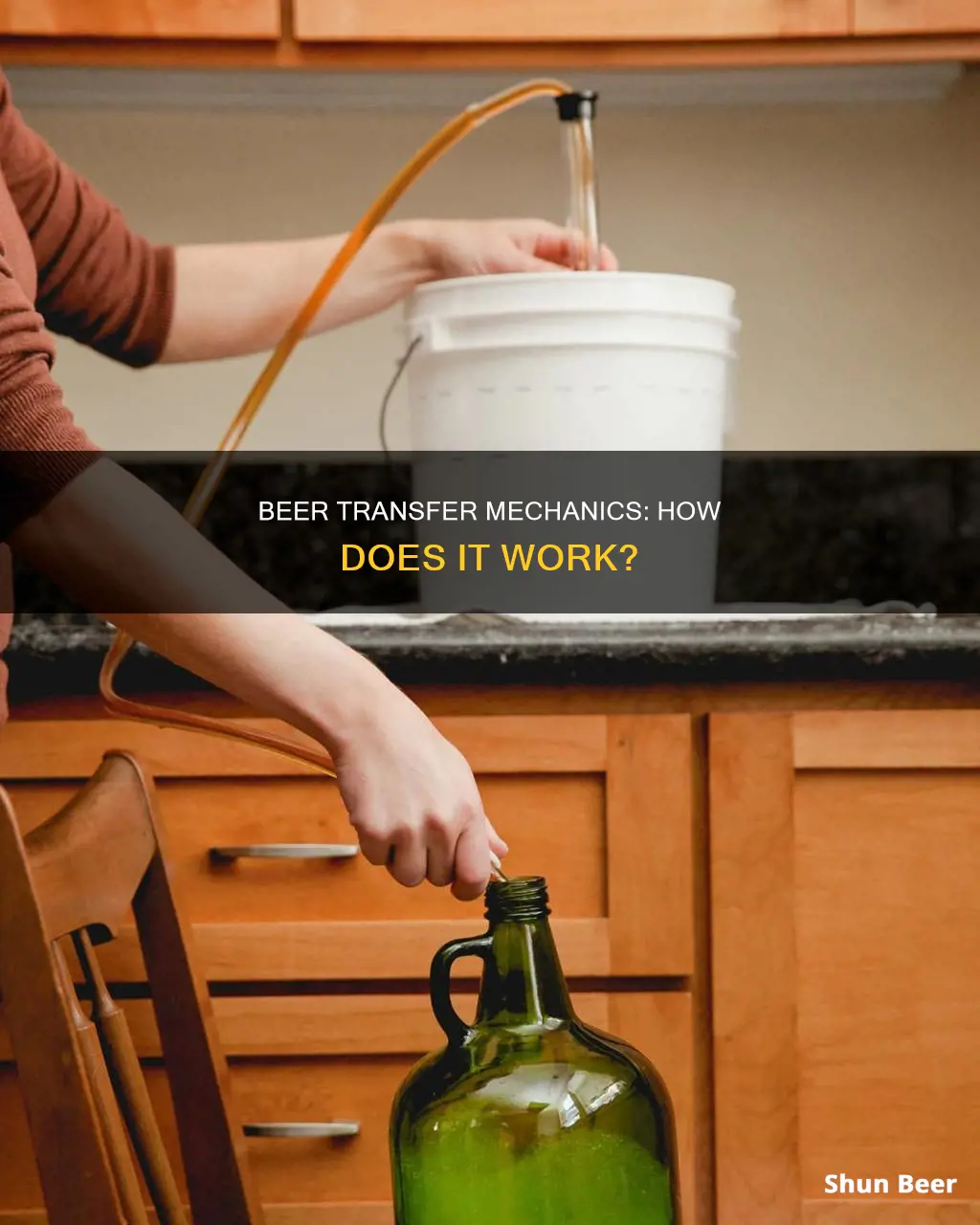
Beer transfer is an important process in brewing, involving moving beer from one container to another without introducing excess oxygen, transferring sediment, or making a mess. This process, known as siphoning or racking, is essential to separate the beer from the sediment, known as trub, that collects at the bottom of the fermentation container. Homebrewers use various techniques and equipment, such as auto-siphons, racking canes, and pumps, to efficiently transfer beer while minimising oxidation and maintaining flavour.
| Characteristics | Values |
|---|---|
| Transferring beer in a home brewery | Relatively quick, without contamination or aeration |
| Commercial brewery transfer | Beer pumped between vessels, potential for over/underpressure situations |
| Homebrew transfer methods | Gravity, pumps, Cornelius kegs |
| Siphoning | Moving beer without introducing oxygen, transferring sediment, or making a mess |
| Racking | Brewing term for moving beer from one container to another |
| Trub | Sediment that gathers at the bottom of the fermentation container |
| Auto-siphon | Skinny tube of hard plastic with a hooked end, used to start a siphon |
| Racking cane | Tube used to start a siphon, often with water or by mouth |
| Spunding valve | Releases excess CO2 at a pre-determined pressure |
| Closed transfer system | Minimising wort's contact with air, achieving naturally carbonated beer |
| Purging | Removing air from a vessel before pitching yeast |
What You'll Learn

Transferring beer using gravity
The easiest way to transfer beer using gravity is when a vessel has a spigot attached. By opening the valve, the liquid flows through clear plastic tubing into the receiving vessel. Adding a spigot, such as a ball valve on a kettle, can save time and energy, despite the higher initial cost.
During transfers, avoiding aeration is crucial, except when transferring cold wort to the fermenter. To minimise aeration, place the outflow end of the tubing at the bottom of the receiving vessel, ensuring the liquid flows directly into it without splashing or fanning down the sides. Once the bottom is covered with liquid, maintain the tubing end below the liquid level. Slightly tilting the receiving vessel and positioning the tubing at the lowest point can help expedite this process.
For vessels without a spigot, such as a glass carboy, a siphoning technique is employed. Homebrewers typically use a racking cane with clear tubing attached, and there are several methods to initiate the siphon:
- By mouth: Place the racking cane in the holding vessel, position the outflow end below, and suck on the tube until the liquid starts flowing. While simple, some brewers avoid this method due to contamination concerns.
- Using water: Fill the racking cane with water, ensuring both ends are level to prevent draining. In a coordinated movement, lower both ends simultaneously, with the cane end entering the holding vessel and the tubing directed into the receiving vessel below. Keep the ends level until the cane is submerged, then quickly drop the tubing into the receiving vessel.
- Siphon starter devices: These are available in various designs, such as a tube within a tube or a marble in a metal cage at one end of the tubing. These devices are easy to use but may be more challenging to clean.
Bottoms Up Beer Dispensers: How Do They Work?
You may want to see also

Siphoning beer
Siphoning is a way of moving beer from one container to another, without introducing a lot of oxygen into the system, transferring a lot of sediment, or making a mess. This process is also known as "racking" in brewing terms.
A siphon works by creating a difference in pressure between two containers, forcing liquid to flow from one to the other. In practical terms, this means placing the full container on a counter and the empty container on a chair or the floor a few feet below, with a hose running between the two. The hose should be submerged in the liquid in the full container, with the outflow end opening into the second container.
There are several methods and tools for starting a siphon, each with its own pros and cons:
Hose and Racking Cane
This is a simple and durable method that comes in starter kits. However, it can be tricky to initiate the siphon. Here are some ways to start the siphon:
- Mouth Start: Directly sucking on the hose to start the siphon, but this poses a high risk of contamination.
- Water or Sanitizer Start: Pre-filling the hose with water or sanitizer and then allowing it to drain can start the siphon, but it requires finesse.
- Turkey Baster Method: Using a sanitized turkey baster to initiate the siphon is an easy and effective alternative.
Sterile Siphon Starter
A more recent addition, the sterile siphon starter simplifies the process. It creates an airtight seal with an orange cap on a carboy and applies pressure through a sterile filter to start the siphon effortlessly. However, it is not universally compatible with all carboy sizes.
AutoSiphon
The AutoSiphon is easy to use, requiring just a few pumps to initiate the siphon. It is particularly useful for low liquid volumes and taking beer samples. However, it has more parts that could potentially break, is pricier, and may not include tubing.
Spigot Attachment
If your holding vessel has a spigot, you can simply open the valve and let the liquid flow through clear plastic tubing into the receiving vessel. This method is quick and easy but may result in more aeration if the outflow end of the tubing is not placed correctly.
Shotgunning Beer: How to Chug Instantly
You may want to see also

Using a racking cane
A racking cane is a skinny tube of hard plastic with a hooked bit on one end. It is used to transfer beer from one container to another, or into bottles, without introducing a lot of oxygen into the system, transferring a lot of sediment, or making a mess. This process is known as siphoning or racking.
To use a racking cane, you will need a hose clamp, a hose or tubing, and a sanitised racking cane and tubing. The racking cane and tubing should be filled with water or sanitiser. Hold the open end of the tube under a running tap and, when water flows out of the other end of the racking cane, tightly clamp the tube closed with the hose clamp.
The racking cane is then slid into the container of beer, with the water staying contained in the tubing. The open end of the tube is then inserted into the new container. With the siphon in place, open the hose clamp and let the water flow into the new container. This will start the flow of liquid, pulling the beer into the siphon.
There are a few other ways to start a siphon. One is to use an auto-siphon, which is a more recent addition that simplifies the process with its design. Another is to use your mouth, although this is not recommended as it can cause contamination. A third way is to use a sterile siphon starter, which creates an airtight seal with an orange cap on a carboy and applies pressure through a sterile filter to start the siphon.
The Science of Beer: Understanding Silos
You may want to see also

One-stage vs two-stage fermentation
One-stage fermentation is the process of fermenting beer in a single container, typically a plastic bucket. This method is simple and allows new brewers to get good beer quickly. One-stage fermentation does not require additional equipment and avoids the risk of contamination associated with transferring beer between containers. However, it may not be suitable for lager beers or high-gravity beers that require longer fermentation times.
Two-stage fermentation, on the other hand, involves transferring the beer from the primary fermenter to a secondary vessel, usually a glass carboy, midway through the fermentation process. This technique is often used for lager beers, high-gravity beers, and highly hopped beers that benefit from extended ageing. The main purpose of the secondary vessel is to facilitate the settling of yeast and to allow the beer to age, mature, and clarify. By removing the beer from the sediment that accumulated during primary fermentation, two-stage fermentation prevents the beer from taking on off-flavours. Additionally, it provides an opportunity for dry-hopping or adding spices, flavourings, or other additives.
The advantages of two-stage fermentation include improved clarity, enhanced flavour, and the ability to free up the primary fermenter for another batch. However, it requires more time and effort and sanitisation practices to avoid contamination. There is also a potential risk of losing hop flavour and introducing oxygen during the transfer process, which can lead to stale flavours.
While two-stage fermentation can be beneficial for certain beer styles and those seeking more complex flavours, one-stage fermentation remains a viable option for many home brewers, especially when time and simplicity are prioritised.
The Magic Inside Beer Cartridges: How Do They Work?
You may want to see also

Closed carboy transfer using CO2 pressure
A closed carboy transfer using CO2 pressure is a method of transferring beer from a carboy to a keg without exposing the beer to oxygen. This can be done using a carboy cap, a racking cane, and a CO2 tank. Here is a step-by-step guide:
- Install a carboy cap with a gas flare fitting and a racking cane.
- Connect the CO2 tank to the carboy headspace, ensuring the regulator is set to a low pressure (around 2-3 PSI).
- Place the carboy higher than the destination keg to assist with gravity.
- Continuously purge the headspace of the carboy with CO2 to prevent oxygen exposure.
- Open the bleed on the keg from time to time to release pressure and prevent equalization.
- Monitor the pressure carefully to avoid over-pressurizing the carboy, which could be unsafe.
- Once the transfer is complete, disconnect the CO2 tank and close the keg.
This method allows for a closed transfer of beer, minimizing oxygen exposure and reducing the risk of contamination. However, it is important to exercise caution when working with glass carboys and pressurized CO2 to ensure a safe transfer.
Beer Sales Strategies During Doubleheaders
You may want to see also
Frequently asked questions
Beer transferring is the process of moving beer from one container to another. This is done to move the beer off any sediment, which can make the beer taste bad if left together for too long.
Beer transferring is not necessary, as you can do a one-stage fermentation and leave the beer in the primary fermenter until bottling. However, transferring the beer to a secondary container means you don't have to worry about bottling right away and it frees up your primary fermenter for another batch.
Beer can be transferred using gravity, a pump, or a closed transfer system. When using gravity, the full container is placed on a counter and the empty container on a chair or the floor a few feet below. A hose is then run between the two containers and the liquid is allowed to flow. A pump can also be used to move the beer between vessels. A closed transfer system minimises the beer's contact with air during the brewing process and achieves a naturally yeast-carbonated beer.
Transferring beer reduces the amount of sediment that gets transferred from one container to the next. It also reduces the introduction of too much oxygen into the beer, which can give it oxidised, sherry-like flavours.







